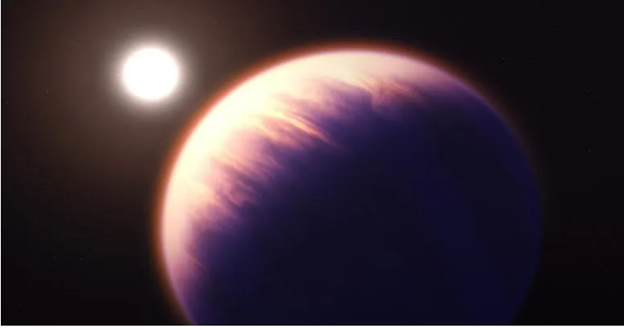by Rida Fatima

(Figure 1: Based on what is known about the planet right now, this graphic depicts what the exoplanet WASP-39 b would look like. WASP-39 b is very hot, puffy full of gas that circulates just 0.0486 au (4,500,000 miles) from its star. It has a diameter that is 1.3 times larger than Jupiter and a mass that is 0.28 times Jupiter (or 0.94 times Saturn). WASP-39 is a star that is somewhat less massive and smaller than the Sun. WASP-39 b is extremely hot due to its near proximity to its star and is most likely tidally locked, with one side constantly facing the side of the star. Credits: www.nasa.gov)
A behemoth the size of Saturn that revolves around its star more closely than Mercury does the Sun, a planet known as WASP-39 b is unmatched by any other planets that exist in our solar system. This exoplanet was one of the first to be studied when NASA started the official science operations on a regular basis by using James Webb Space Telescope. The findings have the exoplanet scientific community in a frenzy. Moreover, potassium, carbon monoxide, Water, sodium, and sulphur dioxide have all been discovered in the profile of WASP-39 b’s atmospheric ingredients created by Webb’s highly sensitive detectors. The results are encouraging for Webb’s sensors’ capacity to carry out a wide range of studies of exoplanets of various types, including rocky, tiny planets that are considered in the TRAPPIST-1 system (Scitechdaily, 2022).
Signatures of molecule with active Chemistry and Clouds
The latest James Webb telescope mission by NASA was to discover the chemical and molecular profile of the skies of a distant world, marking another first. The latest results from Webb show a very comprehensive variety of molecules, atoms, and also some evidence of active chemistry and clouds, in contrast to earlier findings from space observatories, such as Spitzer and NASA’s Hubble. The most recent information also gives a suggestion as to how these clouds would seem up close, suggesting that they are likely split up rather than covering the globe uniformly. The array of the telescope’s highly delicate apparatus was focused right on the environment of WASP-39 b, circulating a star around 700 light-years distant. The results are promising for the ability of Webb’s apparatus to do the extensive range of analyses of all types of exoplanets, or worlds around other stars, that the scientific groups had hoped for. As part of this, it is possible to explore the atmospheres of smaller, stonier planets like those in the TRAPPIST-1 system. It has been noted that the telescope has a variety of equipment that, when combined, offer a wide range of infrared detection and a variety of chemical fingerprints that were previously out of reach. Data like these change the game of understanding these other planets (NASA, 2022).
Five new scientific publications, three of which are in under review and one of which is in press, cover the discoveries in depth. One of the ground-breaking discoveries is that of sulphur dioxide (SO2) for the first time in an exoplanet’s atmosphere. This molecule is the result of chemical processes started by high-energy light from the planet’s parent star. Similar processes are used on Earth to produce the protective ozone layer in the upper atmosphere.
Concrete evidence of photochemistry
The formation of Sulphur dioxide in WASP-39 b’s atmosphere was described in the paper by Shang-Min Tsai, a researcher at the University of Oxford in the United Kingdom. Tsai asserted that this was the first time actual proof of photochemistry—chemical processes initiated by energetic stellar light on exoplanets had been seen. I believe this effort has a highly promising future for enhancing our understanding of the atmospheres of exoplanets. Another first as a result of this was the use of photochemistry computer models on the data that assists with the full explanation of such physics. The ensuing advancements in modelling will contribute to the development of the technological know-how necessary to decipher future indications of habitability (NASA, 2022).
“We had anticipated what the telescope would reveal, but it was more accurate, more varied, and more stunning than I had truly anticipated” – Hanna Wakeford.
Planets circling within the host star’s radiation bath are molded and changed. These changes on Earth enable life to flourish. Eight times closer to its home star than Mercury is to our Sun, the planet serves as a testing ground for the effects of radiation from host stars on exoplanets. Improved comprehension of the star-planet relationship should lead to a greater comprehension of how these factors impact the variety of planets seen in the solar system. Webb followed WASP-39 b when it crossed in front of its star, allowing part of the star’s light to get through the planet’s atmosphere and allowing for the detection of light from the object. Astronomers can identify the molecules by looking at the colors that aren’t present because different kinds of particles in the atmosphere absorb different colors of the starlight range. Webb can identify chemical fingerprints in the universe that are invisible to the human eye by observing it in infrared light.
The Webb telescope also picked up measurements of sodium (Na), potassium (K), and water vapor (H2O), which confirmed earlier observations made by ground- and space-based telescopes and discovered new fingerprints of water at these longer wavelengths (NASA, 2022).
References
- As Never Seen Before: NASA’s Webb Reveals an Exoplanet Unlike Any in Our Solar System. (2022, November). SciTechDaily. Retrieved November 2022, from https://scitechdaily.com/as-never-seen-before-nasas-webb-reveals-an-exoplanet-unlike-any-in-our-solar-system/
- Tsai (2022, November NASA’s Webb Reveals an Exoplanet Atmosphere as Never Seen Before. Exoplanet Exploration: Planets Beyond Our Solar System. Retrieved November 2022, from https://exoplanets.nasa.gov/news/1715/nasas-webb-reveals-an-exoplanet-atmosphere-as-never-seen-before/
